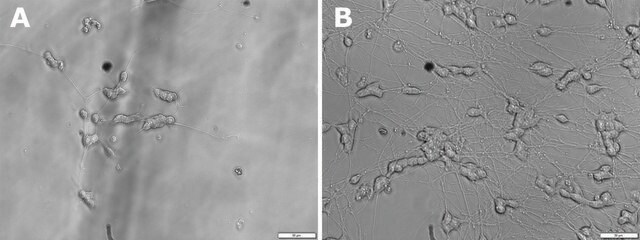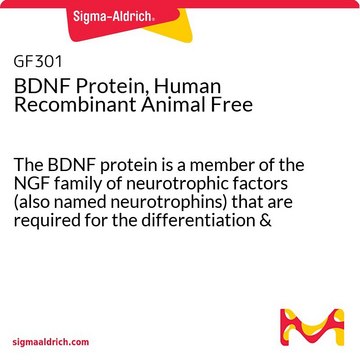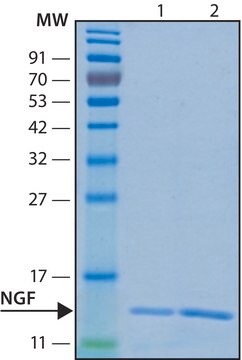GF029
Brain Derived Neurotrophic Factor, recombinant
Iniciar sesiónpara Ver la Fijación de precios por contrato y de la organización
About This Item
UNSPSC Code:
12352200
eCl@ss:
32160405
NACRES:
NA.28
Productos recomendados
General description
FUNCTION: SwissProt: P23560 # Promotes the survival of neuronal populations that are all located either in the central nervous system or directly connected to it. Major regulator of synaptic transmission and plasticity at adult synapses in many regions of the CNS. The versatility of BDNF is emphasized by its contribution to a range of adaptive neuronal responses including long-term potentiation (LTP), long-term depression (LTD), certain forms of short-term synaptic plasticity, as well as homeostatic regulation of intrinsic neuronal excitability.
SIZE: 247 amino acids; 27818 Da
SUBUNIT: Monomers and homodimers. Binds to NTRK2/TRKB.
SUBCELLULAR LOCATION: Secreted.
PTM: The propeptide is N-glycosylated and glycosulfated. & Converted into mature BDNF by plasmin (PLG) (By similarity).
DISEASE: SwissProt: P23560 # Defects in BDNF are a cause of congenital central hypoventilation syndrome (CCHS) [MIM:209880]; also known as congenital failure of autonomic control or Ondine curse. CCHS is a rare disorder characterized by abnormal control of respiration in the absence of neuromuscular or lung disease, or an identifiable brain stem lesion. A deficiency in autonomic control of respiration results in inadequate or negligible ventilatory and arousal responses to hypercapnia and hypoxemia. CCHS is frequently complicated with neurocristopathies such as Hirschsprung disease that occurs in about 16% of CCHS cases.
SIMILARITY: SwissProt: P23560 ## Belongs to the NGF-beta family.
SIZE: 247 amino acids; 27818 Da
SUBUNIT: Monomers and homodimers. Binds to NTRK2/TRKB.
SUBCELLULAR LOCATION: Secreted.
PTM: The propeptide is N-glycosylated and glycosulfated. & Converted into mature BDNF by plasmin (PLG) (By similarity).
DISEASE: SwissProt: P23560 # Defects in BDNF are a cause of congenital central hypoventilation syndrome (CCHS) [MIM:209880]; also known as congenital failure of autonomic control or Ondine curse. CCHS is a rare disorder characterized by abnormal control of respiration in the absence of neuromuscular or lung disease, or an identifiable brain stem lesion. A deficiency in autonomic control of respiration results in inadequate or negligible ventilatory and arousal responses to hypercapnia and hypoxemia. CCHS is frequently complicated with neurocristopathies such as Hirschsprung disease that occurs in about 16% of CCHS cases.
SIMILARITY: SwissProt: P23560 ## Belongs to the NGF-beta family.
Application
Concentration range for most in vitro applications is 0.5 to 100 ng/mL. Responding cells are (partial list): Nerve, glial cells.
Physical form
Sterile filtered, lyophilized with no additives.
Storage and Stability
The lyophilized powder, though stable at room temperature, is best stored desiccated below 0°C. Reconstitute in water to a concentration of 0.1-1.0 mg/mL. This solution can be diluted into water or other buffered solutions. Reconstituted BDNF should be stored in undiluted aliquots at -20°C for up to six months. Avoid repeated freeze/thaw cycles.
Disclaimer
Unless otherwise stated in our catalog or other company documentation accompanying the product(s), our products are intended for research use only and are not to be used for any other purpose, which includes but is not limited to, unauthorized commercial uses, in vitro diagnostic uses, ex vivo or in vivo therapeutic uses or any type of consumption or application to humans or animals.
Storage Class
11 - Combustible Solids
wgk_germany
WGK 1
flash_point_f
Not applicable
flash_point_c
Not applicable
Certificados de análisis (COA)
Busque Certificados de análisis (COA) introduciendo el número de lote del producto. Los números de lote se encuentran en la etiqueta del producto después de las palabras «Lot» o «Batch»
¿Ya tiene este producto?
Encuentre la documentación para los productos que ha comprado recientemente en la Biblioteca de documentos.
Nuestro equipo de científicos tiene experiencia en todas las áreas de investigación: Ciencias de la vida, Ciencia de los materiales, Síntesis química, Cromatografía, Analítica y muchas otras.
Póngase en contacto con el Servicio técnico








